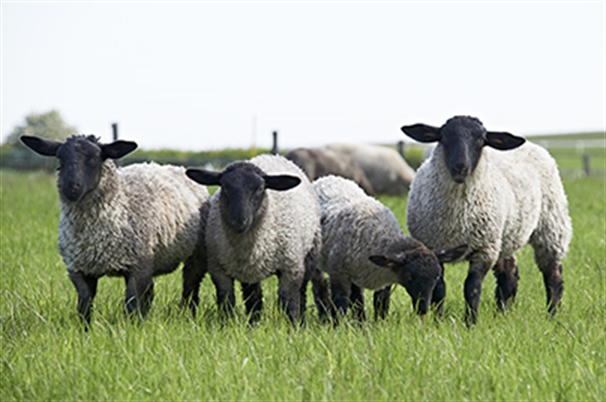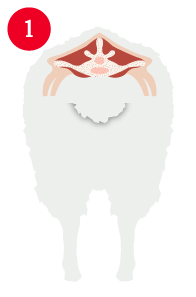
As a sheep farmer, you want to give your business the best chance of securing the highest possible profits. The first step is as simple as measuring the body condition score of your ewes.
Healthy flock, healthy profits
The link between the health of your flock and the health of your business is undeniable. In fact, some experts argue that the single biggest factor affecting the productivity of a flock is low body condition.[i] That’s why it’s so important to measure the body condition score of your ewes regularly. Doing so acts as an early warning system against metabolic disease, being aware of BCS and taking corrective action if needed leads to improved fertility and it makes for healthier lambs.
The trick is to make sure you are measuring body condition score in the right way, and at the right time – whether it’s coming up to lambing season or you are about to begin tupping, or if you are rearing specialist sheep, you need to be familiar with their body condition and how it varies across the year.
Here’s how.
How to measure ewe body condition score
When your list of daily duties is already bulging, you could do without adding tasks to your schedule. The good news is that measuring the BCS of your ewes is surprisingly quick and easy. Once you get into the swing of things – and you will – it takes just a few seconds per sheep.
So, how’s it done?
Run your hand over the spine and loin area, between the last rib and the hip bones of each ewe. You are feeling for fat covering the ‘spinous processes’ (the part of the spine that points upwards) and the ‘transverse processes’ (the bony protrusions from either side of each vertebra). The more prominent the bone feels, the lower the body condition. Remember to account for variations in the wooliness of each ewe; you are feeling for fat/muscle covering the bone, not wool density.
To keep everything consistent, the same person should measure every ewe in your flock. Another important tip is to measure each ewe with the same hand. When the same person measures each ewe in the same way, it’s far easier to detect variance from one sheep to the next.
Body condition is scored on a scale from 1.0 to 5.0 and increases in increments of 0.5. A score of 1.0 is very thin and 5.0 is very fat.
Here’s a guide to what each interval on the scoring scale will feel like.[ii]
A guide to ewe body condition scores
1.0 - The spine and vertebra will feel prominent and sharp. You will easily be able to feel and push your fingers below each one. The loin will be sunken and shallow, with very little fat cover.
2.0 - The spine will still be prominent but will feel smoother, with individual vertebra felt as folds below the fat and muscle. You will still be able to press your fingers below the transverse processes with minimal pressure. The loin is a moderate depth but with a little fat cover.
3.0 - The bony posterior of each vertebra will feel smooth and rounded. You will only be able to feel the bone by applying pressure. Hard pressure will be necessary to feel the end of the vertebra. The loin is full and has moderate amounts of fat cover.
4.0 - The bony posterior of the spine is only detectable as a line, and you cannot feel the ends of each vertebra. The loin is full and rounded, with a thick covering of fat.
5.0 – Even with pressure you will not be able to feel any part of the spine. There may be a dimple in the layers of fat where the vertebra should be. The loin is very full and covered with thick fat.





Where should your ewes fall on the body condition scale?
Essentially ewes that have a body condition score of 1.0 are underfed and skinny, while those with a score of 5.0 are overfed and fat. The ideal range for positive fertility and health outcomes is between 3.0 and 3.5 – no matter what time of year it is.[iii] To maintain the health of your flock, measure body condition score every three to six months and record the numbers. Doing so will allow you to assess the average condition of your flock and monitor any changes to individual ewes over time. Intervening when you notice changes to body condition will allow you to make the necessary changes to ensure your flock are healthy and ready for key stages in their production cycles.
If you only measure twice, measure here…
There are two key stages in the sheep calendar when it’s particularly important to measure the body condition of your flock: eight weeks before tupping, and eight weeks before lambing.
A healthy body condition score makes for positive outcomes during these key processes. If something is not where it should be when you measure your flock, eight weeks gives you enough time to make the nutritional corrections to get individual ewes fit for production.
Fertility is more likely to be at its best with ewes that have a healthy body condition score, making tupping more efficient. Meanwhile, a healthy score in the build up to lambing will help to ensure lambs grow healthily and can reduce the risk of complications at birth such as underweight lambs or a prolapse. Having a healthy ewe will also ensure she can produce adequate supplies of nutrient-rich colostrum and milk for her lambs.
What next?
Managing the nutrition of your flock can be a delicate balancing act – particularly pre-lambing when a ewe’s energy demands are high. For all the advice you need on getting the balance right and maintaining the productivity of your flock, head to lamlac.com, or join our community on Facebook and Twitter.
[i] Beef & Lamb New Zealand: Ewe body condition scoring
[iii] Beef & Lamb New Zealand: Ewe body condition scoring